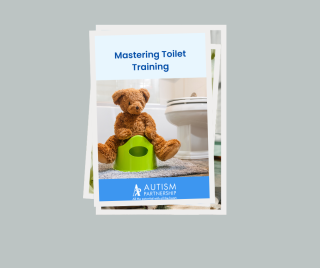Navigating toilet training for autistic children
Toilet training can be a challenging process for children with autism. However, with patience, consistency, and individualised strategies, it is possible to support autistic children in achieving toileting independence. Here are some useful tips, strategies and things to consider before starting the toilet training process.
Is your child ready?
Does your child have longer periods of dryness? Can your child hold their urine and urinate in larger amounts so that they are not releasing small amounts frequently throughout the day? To check this, do wet and dry nappy checks regularly. This will give you good information on how often they are urinating. If your child is urinating extremely frequently in short amounts, it might be better to wait if possible.
Is your child comfortable entering the bathroom and sitting on the toilet or potty? If not, practise the following first.
- Over a period of time, create time in the day to practise. Break down the toileting process into smaller, manageable steps. Focus on teaching one step at a time, gradually building up to the complete routine. For example, start with transitioning progressively closer to the bathroom, then sitting on the toilet fully clothed, and finally, sitting with their clothes removed, providing lots of praise and fun activities.
- The use of visuals can help some children “ first (picture of the bathroom) then (picture of a fun activity)”.
- You can also associate the bathroom with fun activities, e.g. blowing bubbles in the bathroom, making the experience less daunting for your child.
Download a copy of our Navigating Toilet Training Resources booklet.
Preparation is key!
Being prepared can dramatically increase the success of the toilet training process. Some things to consider are:
Where will your child go to the toilet? On the toilet or potty? Depending on your child’s age, it may be easier to start with the toilet, as switching between the potty and the toilet can take some teaching. If you are beginning by using the toilet, ensure you have everything you need for your child to get on and off the toilet independently and comfortably, e.g. a comfy toilet seat insert and a step to climb up.
How will your child request to go to the toilet? Options could include a picture of the toilet that they can hand over, a verbal request or a hand sign.
Do you have lots of pants and trousers at the ready? There may be lots of washing in the first few days. Trousers that don’t have fasteners and are easy to pull up and down can be helpful. Also, think about coverings for household furnishings and car seats.
How will you motivate your child to go to the toilet? Lots of kids need extra motivation to use the toilet. Spend some time thinking about and gathering items that you can use as a reward for your child using the toilet.
When to start? It can be helpful to have a few days just at home in the initial stages. The child you are toilet training will most likely take up lots of your time and attention. Extra support at home can be helpful.
Download a copy of our Navigating Toilet Training Resources booklet.
Getting started
There are two main methods for toilet training – intensive and scheduled toilet training. Each has its advantages and disadvantages and suits different children.
Intensive toilet training
This method is great for children who will drink lots of fluids and are happy to sit on the toilet. The main aim is to create lots of opportunities to practise urinating in the toilet and encourage your child with lots of praise and fun activities. The frequent practice can help kids become motivated to use the toilet and understand how to hold their urine, release and initiate using the toilet much quicker than scheduled toilet training.
- Start by providing the child with lots of fluids and sitting on the toilet and waiting for them to urinate. You want to make sure this is fun, so ensure you have lots of activities ready. Your child should be happy and relaxed in the bathroom and on the toilet during this time.
- When they do urinate, draw their attention to it and provide lots of praise/fun activities, whatever is motivating for your child.
- Once successful here, gradually start moving further away from the toilet and slowly start engaging in everyday activities so that your child can begin to recognise when they need to urinate and pop themselves on the toilet.
- Finally, reduce the fluids to their average daily amount previously, as you no longer need to create as many opportunities to practise.
Intensive toilet training should be a quick process. Although you may spend lots of time in the bathroom for the first couple of days, you should then be able to transition further away from the toilet.
Scheduled toilet training
The aim here is to create an individualised schedule for your child and take them to the bathroom at those times; gradually increasing the schedule over time to teach them the ability to hold their urine and initiate that they need to use the bathroom.
- To determine the schedule, do wet/dry nappy checks frequently to gauge how often your child is urinating. If it is approximately every 90 minutes, you would time your schedule slightly less at around every 80 minutes.
- If your child does not urinate when you take them to the bathroom, return 15 minutes later, and keep going every 15 minutes until your child eliminates.
- Once they have urinated, return your initial scheduled time of 80 minutes.
- As your child is successful, gradually lengthen the schedule each day. If your child is going less frequently than you had originally thought, it’s okay to adapt the schedule to longer durations. It can be really frustrating for them to be taken to the toilet lots of times when they don’t need to go.
Tips for success!
Motivation and positive reinforcement have been mentioned frequently. This can be whatever works for your child; verbal praise, a preferred toy or activity, or a sticker chart, to reinforce successful toileting attempts. Celebrate each step of progress to keep them engaged and motivated.
Save the motivators – to keep your child engaged, save the items you are using to help motivate your child for toilet training exclusively for this activity. For many families, having a box that they keep in the bathroom full of the things that encourage their child can be really successful.
Initially, some children tend to hold their urine once their nappy is removed as they become comfortable with the new sensation of no nappy. Be aware this may happen; it can help explain potentially long periods of not urinating initially.
Associations – associating the nappy going on with pyjamas at the end of the day and being removed when they get dressed out of pyjamas in the morning can be a clear way to help children understand when they need to use the toilet versus when their nappy is on.
Avoid using absorbent underpants, as this can feel a little like a nappy for your child and create confusion about when to urinate in the toilet.
Wet/dry pants check: this is where you check your child’s pants as to whether they are wet or dry and provide positive reinforcement if they are dry. In the early stages, this can be a good motivator for a child and a helpful reminder. Although not essential, it can also be beneficial to teach your child the concept of wet/dry.
Can your child independently pull down and pull up their pants? Again, although not essential, it can be useful to teach your child this first.
Seek professional support – if you’re encountering significant difficulties or your child’s progress is slow, consider consulting with a Paediatrician, Occupational Therapist, or Behavioural Specialist with experience in autism. They can provide further guidance and personalised strategies.
Remember, every child is unique, so be patient and flexible throughout the process. Celebrate small wins and provide plenty of support and encouragement. With time and consistent effort, your child can achieve success in toilet training.
More information and resources
For information, download our Navigating Toilet Training booklet.


About the Author
Louise Baldwin has been working with autistic children for over 25 years. She holds a Masters in Applied Behavioural Analysis from St. Cloud State University. Louise is Autism Partnership’s Clinical Director for NSW. Based at Autism Partnership’s Sydney Centre, she oversees Autism Partnership’s NSW services. Louise also facilitates staff development and mentoring opportunities for our NSW Behaviour Therapists and Consultants.
Subscribe to our newsletter
For information about our FREE parent talks, handy resources and all our latest news.



